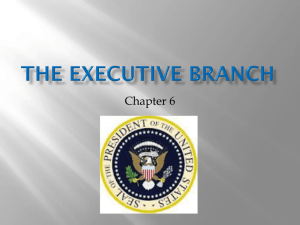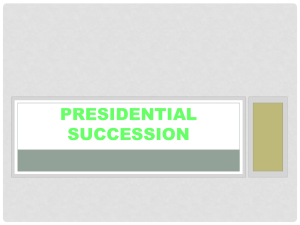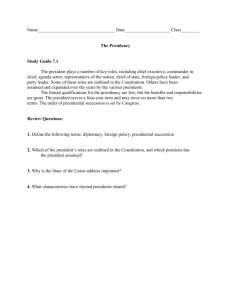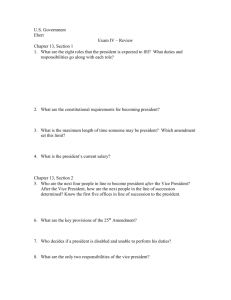Presidential Succession and the VP (13
advertisement
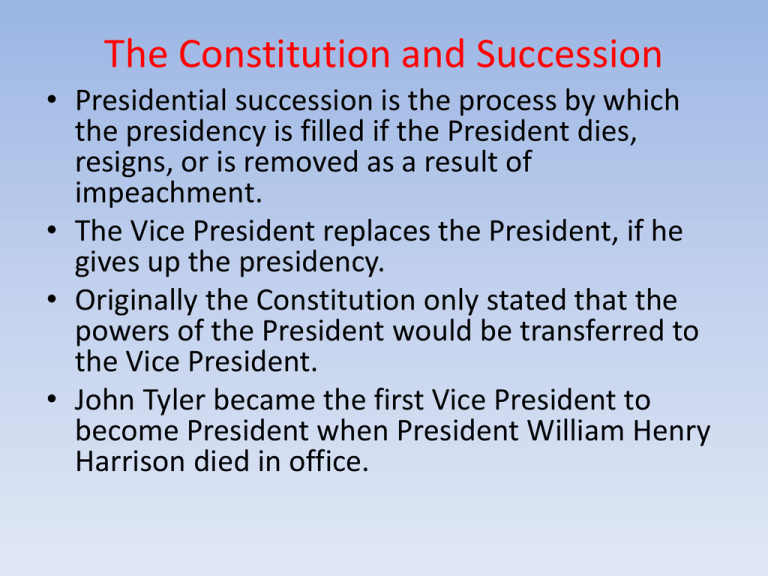
The Constitution and Succession • Presidential succession is the process by which the presidency is filled if the President dies, resigns, or is removed as a result of impeachment. • The Vice President replaces the President, if he gives up the presidency. • Originally the Constitution only stated that the powers of the President would be transferred to the Vice President. • John Tyler became the first Vice President to become President when President William Henry Harrison died in office. The Presidential Succession Act of 1947 • The Presidential Succession Act of 1947 fixed the order of succession following the Vice President. • By its terms the Speaker of the House is next in line, followed by the President Pro Tem of the Senate who is followed by the Secretary of State and all the Cabinet officials in the order their cabinet positions were created by Congress. • The most recently created cabinet position is the last in the line of succession. Order of Presidential Succession Presidential Succession 1. Vice President 2. Speaker of the House 3. President Pro Tempore of the Senate 4. Secretary of State 5. Secretary of the Treasury 6. Secretary of Defense 7. Attorney General 8. Secretary of the Interior 9. Secretary of Agriculture 10. Secretary of Commerce 11. Secretary of Labor 12. Secretary of Health and Human Services 13. Secretary of Housing and Urban Development 14. Secretary of Transportation 15. Secretary of Energy 16. Secretary of Education 17. Secretary of Veteran's Affairs 18. Secretary of Homeland Security Presidential Disability • Neither the Constitution itself or Congress had any provisions for Presidential disability. • President Eisenhower was disabled 3 times during his presidency in the 1950s. • James Garfield lingered for 80 days before dying from an assassin's bullet. • Woodrow Wilson suffered a stroke that left him incapacitated for the remainder of his second term. • The Twenty-Fifth Amendment in 1967 settled the issue. • It stated that the Vice President is to become the acting President if the President informs Congress in writing that he cannot perform his duties or the Vice President and a majority in the cabinet inform the Congress in writing that the President cannot perform his duties. Presidential Disability • The President may then resume his powers when he informs Congress that he is no longer incapacitated. • This may be challenged by the Vice President and a majority of the cabinet—in this case Congress has 21 days to act on the issue. • Ronald Reagan was incapacitated briefly due to surgery in 1985. The Vice Presidency • The Constitution does not pay much attention to the office of the Vice Presidency. • It gives the Vice President two duties—Preside over the Senate and help decide the question of presidential disability. • John Adams, our first vice president, held the vice presidency was “the most insignificant office that ever the invention of man contrived or his imagination conceived.” • The office is an important one, because the Vice President is a “heartbeat” away from the presidency. • Eight presidents have died in office and one (Richard Nixon) was forced to resign as a result of Watergate. • The presidential candidate tries to pick a vice president who will “balance the ticket”—increase the chances of being elected due to geographic, racial, gender, ethnic, or other characteristics. Vice Presidents who have Succeeded to the Presidency Successor Reason for Succession John Tyler William Henry Harrison's death in 1841 Millard Filmore Death of Zachary Taylor in 1850 Andrew Johnson Assasination of Abraham Lincoln in 1865 Chester A. Arthur Assasination of James A Garfield in 1881 Theodore Roosevelt Assassination of William McKinley in 1901 Calvin Coolidge Death of Warren G. Harding in 1923 Harry S. Truman Death of Franklin Roosevelt in 1945 Lyndon Johnson Assassination of John F. Kennedy in 1963 Gerald Ford Resignation of Richard Nixon in 1974 Vice Presidential Succession • There have been 18 instances in which the office of the Vice President has been vacant—9 times by succession to the presidency, 2 times by resignation, and 7 times by death. • The 25th Amendment resolved the Succession Issue—Whenever there is a vacancy in the office of the Vice President, the President will appoint a replacement who must be approved by a majority vote by both houses of Congress. • Richard Nixon in 1973 selected Gerald Ford who replaced Spiro Agnew who had resigned. The Vice Presidency Today • Today’s Vice President is Joe Biden. • Even today the President has been unwilling to make the Vice President a true “assistant”—only the Vice President cannot under any circumstances be removed from office by the President—he cannot be fired by the President.


